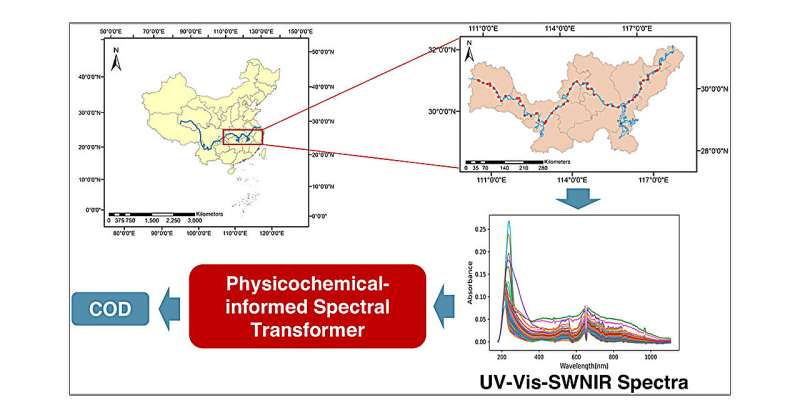
April 9, 2025 by Liu Jia, Chinese Academy of Sciences
Collected at: https://phys.org/news/2025-04-ai-spectroscopy-enables-rapid-quality.html
A research team led by Prof. Hu Bingliang and Prof. Yu Tao from the Xi’an Institute of Optics and Precision Mechanics (XIOPM) of the Chinese Academy of Sciences has developed the physicochemical-informed spectral Transformer (PIST) model combined with ultraviolet-visible-shortwave near-infrared (UV–vis-SWNIR) spectroscopy for water quality sensing. Their study is published in Environmental Science & Technology and was selected as a cover article.
“Our research capitalizes on integrating fundamental physicochemical properties into the Transformer architecture,” said Prof. Liu Jiacheng from XIOPM and the first author of this study. “AI-enhanced spectroscopic technologies hold promise for environmental monitoring as powerful tools.”
Spectroscopy, which detects the absorption of light at specific wavelengths by electrons in pollutant molecules, is widely used for water quality analysis. The core challenge lies in building accurate and generalizable models to quantitatively relate spectral signals to water quality indices.
Traditional models such as partial least squares (PLS) and convolutional neural networks (CNNs), though widely used, face limitations in spectral feature extraction and generalizability across varying conditions.
In this study, researchers introduced the PIST architecture—the first Transformer-based model tailored for water quality spectroscopic analysis. This architecture incorporates a physicochemical-informed block to enable domain adaptation and a feature embedding block to enhance global feature extraction, significantly improving model performance.
Experimental validation confirmed the PIST model’s high accuracy and generalizability in measuring chemical oxygen demand (COD) concentrations. Combined with UV–vis-SWNIR spectroscopy, the model provides a rapid, reliable, and low-cost solution for water quality assessment. Furthermore, when deployed with in situ spectral collection devices, it has the potential for long-term environmental monitoring and fast response to water pollution emergencies.
This study marks a step forward in the application of AI-driven methods for environmental protection, offering new opportunities for intelligent water quality monitoring.
More information: Jiacheng Liu et al, Rapid COD Sensing in Complex Surface Water Using Physicochemical-Informed Spectral Transformer with UV–Vis-SWNIR Spectroscopy, Environmental Science & Technology (2025). DOI: 10.1021/acs.est.4c14209
Journal information: Environmental Science & Technology

Leave a Reply